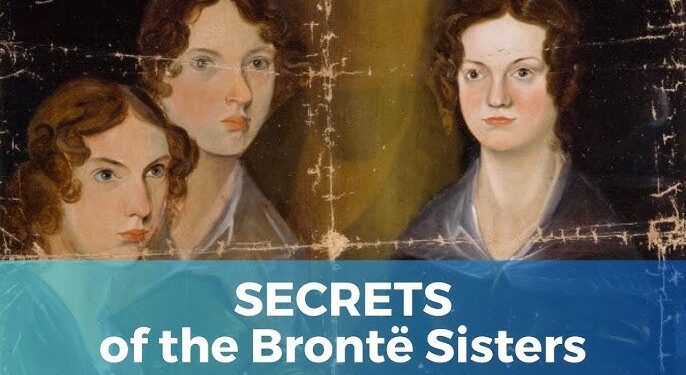Introduction
The Brontë Sisters Secrets Behind Iconic Novels With their novels that continue to enthrall readers of all ages, the Brontë sisters—Charlotte, Emily, and Anne—are among the most recognizable characters in English literature. The Brontë family, who were born in the remote Yorkshire village of Haworth at the beginning of the 19th century, had to deal with a number of difficulties, such as the early death of their mother and the passing of their siblings.
Charlotte, Emily, and Anne would go on to compose some of the most significant works of the Victorian era, changing the course of English fiction, in spite of these personal tragedies.
The Brontës are renowned for their pioneering books that explored the intricacies of gender roles, the darker sides of human nature, and societal restraints. Literary classics Anne’s The Tenant of Wildfell Hall, Emily’s Wuthering Heights, and Charlotte’s Jane Eyre all provide striking portrayals of intense love, psychological nuance, and social critique. But it wasn’t an easy road to writing novels with such impact.
The Brontë sisters had a difficult time getting their writing published and recognized by the literary establishment since women writers were frequently marginalized in their day. Because they were worried that their works, which frequently dealt with contentious issues like sexuality, class, and the role of women, would be disapproved of if their true names were made public, they first published under male pseudonyms, Currer, Ellis, and Acton Bell.
The Brontës have always been mysterious because of the secrecy of their writings, the depth of their characters, and their unapologetic criticism of society.
The secrets of the Brontë sisters’ well-known novels are examined in this article, along with the distinctive aspects of their lives that shaped their writing, recurrent themes in their books, and the ways in which their literary legacies have endured. From their turbulent personal lives to their inventive storytelling techniques, the Brontës’ books are still required reading because they provide deep insights about social systems, human psychology, and emotional fortitude.
1. Charlotte Brontë: The Power of Independent Women
Charlotte Brontë, the eldest of the three Brontë sisters, is perhaps best known for her classic novel Jane Eyre, which has become one of the most beloved books in English literature. Published in 1847, Jane Eyre tells the story of an orphaned girl who overcomes immense adversity to find love and independence. At its heart, the novel is a fierce critique of the societal expectations placed on women during the Victorian era, as well as an exploration of themes such as self-respect, integrity, and the pursuit of happiness.
Read more
A. Autonomy and Gender Roles
Through the character of Jane, Charlotte Brontë challenges the traditional roles of women in her society. Jane refuses to submit to the demands of others and chooses a path of self-reliance, making her one of the earliest feminist heroines in English literature. Brontë’s exploration of Jane’s internal struggles, her desire for independence, and her refusal to accept the limited roles offered to women in the 19th century are central to the novel’s power.
Charlotte Brontë’s own life mirrored some of the struggles experienced by her characters. Raised in a strict, often oppressive environment, Brontë was acutely aware of the limitations imposed on women. Her novel Jane Eyre embodies her own belief in the importance of self-empowerment, resilience, and the need for women to carve out their own space in the world. The novel’s success was revolutionary in its time, as it captured the hearts of readers with its unapologetic portrayal of a strong, complex female protagonist.
B. Gothic Influences
Charlotte’s later works, such as Shirley and Villette, also continue this exploration of strong women navigating difficult and oppressive circumstances. Drawing from her personal experiences of loss and isolation, Charlotte’s novels are often imbued with a sense of melancholy and emotional depth, further influenced by the gothic genre. Much like Jane Eyre, these later novels feature women struggling for autonomy and the right to define their own lives.
2. Emily Brontë: Passion and the Darker Sides of Love
Emily Brontë’s sole novel, Wuthering Heights, is a powerful exploration of love, obsession, and revenge. Published in 1847, Wuthering Heights is often considered one of the greatest works of English literature, yet its unusual structure and dark, tumultuous themes left critics and readers divided. The novel’s portrayal of the wild, destructive love between Heathcliff and Catherine Earnshaw defies conventional norms of romanticism and instead paints a picture of love as an uncontrollable, often dangerous force.
A. Nature and the Supernatural
The Brontë Sisters Secrets Behind Iconic Novels One of the defining characteristics of Wuthering Heights is its intense connection to nature. The bleak, wind-swept moors of Yorkshire form the novel’s haunting backdrop, symbolizing the wild and untamed emotions of its characters.
The isolation of Wuthering Heights itself—an old, remote manor—becomes a metaphor for the emotional desolation that the characters experience. The novel is also infused with elements of the gothic, with themes of ghostly hauntings, revenge, and the blurred line between life and death.
Emily’s personal life is often seen as a reflection of the themes of isolation and mystery that dominate Wuthering Heights. Emily was known to be a reclusive figure, rarely leaving her home in Haworth and maintaining a strong attachment to the natural world. It is believed that her love for the Yorkshire moors heavily influenced her depiction of the setting and characters in Wuthering Heights.
B. Complex Depictions of Love and Revenge
The Brontë Sisters Secrets Behind Iconic Novels In Wuthering Heights, Emily Brontë presents love not as an idealized, rosy emotion but as something wild and untamed. The passionate love between Catherine and Heathcliff is destructive and obsessive, fueled by both longing and vengeance.
Brontë’s portrayal of love as something darker and more complex was groundbreaking for its time and continues to captivate readers for its raw emotional intensity.

3. Anne Brontë: Feminism and Social Critique
The Brontë Sisters Secrets Behind Iconic Novels Anne Brontë, the youngest of the Brontë sisters, is perhaps the least well-known of the trio, but her works are no less significant in their impact on literature. Her most famous novels, Agnes Grey and The Tenant of Wildfell Hall, are ahead of their time in their portrayal of strong, independent women defying societal expectations.
A. The Struggles of Marriage and Gender Norms
The Tenant of Wildfell Hall was especially radical for its treatment of marriage and women’s roles within it. In this novel, Anne Brontë addresses the damaging effects of alcoholism and an abusive marriage, shedding light on the emotional and psychological toll that such a relationship can take on a woman.
The novel’s candid approach to these difficult topics was controversial at the time, but it also offered an early feminist critique of marriage and gender dynamics, reflecting Anne’s belief in the need for women’s autonomy and self-respect.
Read more
B. Critiques of Social Expectations
The Brontë Sisters Secrets Behind Iconic Novels Anne’s works, like Agnes Grey, also provide a window into the difficult lives of governesses, a profession that was dominated by women but offered little power or respect.
Through the character of Agnes, Anne Brontë reveals the harsh realities of working in upper-class households, where women were expected to be self-sacrificing and subservient. Agnes Grey is a testament to Anne’s ability to bring attention to the struggles of women in domestic settings, highlighting themes of social class, gender inequality, and self-worth.

Conclusion
Each of the Brontë sisters’ writings delved into the most profound facets of human emotion, social norms, and individual freedom, making them some of the most influential authors in English literary history. Through their observations of the world and their own struggles, Charlotte, Emily, and Anne created novels that are still relevant today because of their social criticism and emotional depth.
While Anne Brontë elevated feminism and social critique in The Tenant of Wildfell Hall, Emily Brontë questioned conventional ideas of love and obsession with the eerie Wuthering Heights, and Charlotte Brontë transformed the representation of autonomous women in Jane Eyre.
The Brontë Sisters Secrets Behind Iconic Novels Their combined works provide a profound commentary on the intricacies of power, gender, identity, and love. They violated taboos, pushed limits, and influenced literature in ways that still have an impact on readers and writers today.
The Brontë Sisters Secrets Behind Iconic Novels The Brontë sisters’ personal lives, marked by tragedy, loss, and isolation, undeniably shaped their literary works. Through their stories, they gave voice to women’s experiences and explored the darker sides of human nature with unparalleled sensitivity and intelligence. Their works remain essential reading, and their legacy continues to inspire generations of readers, making them timeless figures in the world of literature.
Read more
FAQ
1. What are the key themes in the Brontë sisters’ novels?
The Brontë sisters explored numerous themes, including gender roles, love, obsession, social class, independence, and the complexities of marriage. Their works often challenged societal expectations and depicted powerful, independent characters, particularly women, navigating the confines of 19th-century society.
2. How did the Brontë sisters influence feminist literature?
The Brontë sisters, particularly Charlotte and Anne, contributed significantly to feminist literature by portraying women who were not bound by traditional roles. In novels like Jane Eyre and The Tenant of Wildfell Hall, they explored themes of female independence, the struggles within marriage, and the need for autonomy and self-respect, providing early critiques of gender inequalities.
3. Why did the Brontë sisters publish under male pseudonyms?
The Brontë sisters initially published under male pseudonyms—Currer, Ellis, and Acton Bell—because of the prevailing social norms that discouraged female authorship. They feared that their works would be dismissed if their gender was known, particularly given the controversial themes they addressed, such as passion, love, and social criticism.
4. What makes Wuthering Heights different from other Victorian novels?
Wuthering Heights stands out for its portrayal of love as a raw, destructive force rather than the idealized, restrained emotion typically depicted in Victorian novels. Emily Brontë’s exploration of obsession, revenge, and the blurred lines between love and hatred, along with the novel’s gothic elements, makes it a unique and groundbreaking work in literature.
5. How did the Brontë sisters’ personal lives influence their novels?
The Brontë sisters’ personal lives were marked by loss, isolation, and hardship, and these experiences influenced the themes of their novels. The deaths of their mother and siblings, as well as their secluded upbringing in Haworth, are reflected in their works, which often feature characters who wrestle with loneliness, societal rejection, and personal tragedy.
Read more
















